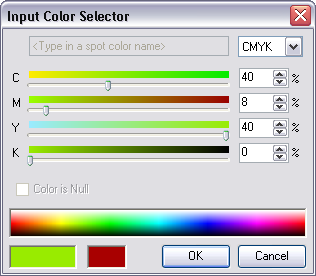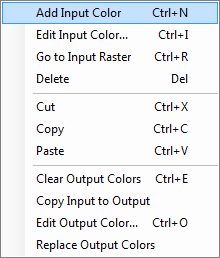Disponible con licencia de Production Mapping.
Color mapping rules allow you to replace colors displayed on a map or chart with other colors during export to PDF using the Production PDF exporter. These rules specify an input color and a replacement output color. You can convert between colorspaces through the Color Mapping Rules dialog box. You access this dialog box from the Production tab on the Export Map dialog box.

Once you have defined color mapping rules, you can save them to an .xml file. This allows you to share and reuse rules.
Color selection
Input colors can come from the map display. You can define your own input colors using the Input Color Selector dialog box. The Input Color Selector dialog box can create input colors in RGB or CMYK colorspaces only. You use the Output Color Selector dialog box to define output colors in RGB, CMYK, Spot, or All (typically used to define printer marks). The output color can also be defined to be a null color (no color). Null colors cannot be defined as input colors.

The Color Mapping Rules dialog box context menu
The Color Mapping Rules dialog box has rows of colors and columns that contain descriptive information about those colors. Right-clicking any row displays a context menu. Holding down the Select or Ctrl keys when a row is selected allows multiple rows to be selected. Not all context menu commands are enabled or work when multiple rows are selected.

| Option | Description | Note/Active Status |
|---|---|---|
Add Input Color | Creates a new color mapping rule with input color in the dialog box. The default value of the input color matches the existing selected rule or CMYK 100 100 100 0 if no rule exists. | Always active |
Edit Input Color | Changes an existing input color in the dialog box | Active when multiple input colors exist in the dialog box |
Add Input Raster | Adds an 8-bit grayscale raster color mapping rule to the dialog box | Active when a grayscale raster color mapping rule does not exist in the dialog box When a grayscale raster color mapping rule exists in the dialog box, the Go to Input Raster command is displayed. |
Go to Input Raster | Selects the grayscale raster color mapping rule in the dialog box | Active when a grayscale raster color mapping rule exists in the dialog box and is not currently selected When a grayscale raster color mapping rule does not exist in the dialog box, the Add Input Raster command is displayed. |
Delete | Removes a color mapping rule from the dialog box | Active when one or more rules are selected |
Add Input Raster | Adds an 8-bit grayscale raster color mapping rule to the dialog box | Always active |
Cut | Removes a color mapping rule from the dialog box and places it on the clipboard | Active when a rule is selected in the dialog box |
Copy | Copies a color mapping rule from the dialog box and places it on the clipboard | Active when a rule is selected in the dialog box |
Paste | Pastes a color mapping rule from the clipboard onto the dialog box | Active when a rule is either cut or copied |
Clear Output Colors | Clears an output color from a color mapping rule in the dialog box | Active when all selected rules contain output colors |
Copy Input to Output | Copies an input color to its corresponding output color column | Active when one or more rules are selected |
Edit Output Color | Changes an output color in the dialog box | Active when one rule is selected |
Replace Output Colors | Pastes an output color from the clipboard to an existing rule in the dialog box | Active when a color mapping rule was copied earlier and one or more rules are selected |